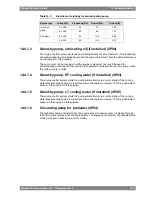
Smoke can be black, blue, white, yellow or brown in appearance. Black smoke is mainly
comprised of carbon particulates (soot). Blue smoke indicates the presence of the products
of the incomplete combustion of the fuel or lubricating oil. White smoke is usually condensed
water vapour. Yellow smoke is caused by NO
x
emissions. When the exhaust gas is cooled
significantly prior to discharge to the atmosphere, the condensed NO
2
component can have
a brown appearance.
13.2
Marine exhaust emissions legislation
13.2.1
International Maritime Organization (IMO)
The increasing concern over the air pollution has resulted in the introduction of exhaust
emission controls to the marine industry. To avoid the growth of uncoordinated regulations,
the IMO (International Maritime Organization) has developed the Annex VI of MARPOL 73/78,
which represents the first set of regulations on the marine exhaust emissions.
13.2.1.1
MARPOL Annex VI - Air Pollution
The MARPOL 73/78 Annex VI entered into force 19 May 2005. The Annex VI sets limits on
Nitrogen Oxides, Sulphur Oxides and Volatile Organic Compounds emissions from ship
exhausts and prohibits deliberate emissions of ozone depleting substances.
Nitrogen Oxides, NO
x
Emissions
The MARPOL 73/78 Annex VI regulation 13, Nitrogen Oxides, applies to diesel engines over
130 kW installed on ships built (defined as date of keel laying or similar stage of construction)
on or after January 1, 2000 and different levels (Tiers) of NOx control apply based on the ship
construction date. The NO
x
emissions limit is expressed as dependent on engine speed. IMO
has developed a detailed NO
x
Technical Code which regulates the enforcement of these rules.
EIAPP Certification
An EIAPP (Engine International Air Pollution Prevention) Certificate is issued for each engine
showing that the engine complies with the NO
x
regulations set by the IMO.
When testing the engine for NO
x
emissions, the reference fuel is Marine Diesel Oil (distillate)
and the test is performed according to ISO 8178 test cycles. Subsequently, the NO
x
value has
to be calculated using different weighting factors for different loads that have been corrected
to ISO 8178 conditions. The used ISO 8178 test cycles are presented in the following table.
Table 13-1
ISO 8178 test cycles
100
100
100
100
100
Speed (%)
D2: Constant-speed
auxiliary engine applica-
tion
10
25
50
75
100
Power (%)
0.1
0.3
0.3
0.25
0.05
Weighting
factor
100
100
100
100
Speed (%)
E2: Constant-speed
main propulsion applica-
tion including diesel-
electric drive and all
controllable-pitch pro-
peller installations
25
50
75
100
Power (%)
0.15
0.15
0.5
0.2
Weighting
factor
13-2
Wärtsilä 32 Product Guide - a21 - 7 September 2016
Wärtsilä 32 Product Guide
13. Exhaust Emissions
Summary of Contents for WARTSILA32
Page 18: ...This page intentionally left blank...
Page 72: ...This page intentionally left blank...
Page 130: ...This page intentionally left blank...
Page 150: ...This page intentionally left blank...
Page 186: ...This page intentionally left blank...
Page 204: ...This page intentionally left blank...
Page 210: ...This page intentionally left blank...
Page 216: ...This page intentionally left blank...
Page 238: ...This page intentionally left blank...
Page 246: ...This page intentionally left blank...
Page 248: ...This page intentionally left blank...
Page 251: ......
Page 252: ......
Page 253: ......
















































